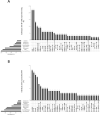May Measure Month 2022 in Italy: A Focus on Fixed-dose Combination, Therapeutic Adherence, and Medical Inertia in a Nationwide Survey
- PMID: 38825650
- PMCID: PMC11161440
- DOI: 10.1007/s40292-024-00642-4
May Measure Month 2022 in Italy: A Focus on Fixed-dose Combination, Therapeutic Adherence, and Medical Inertia in a Nationwide Survey
Abstract
Introduction: Hypertension is the main risk factor for cardiovascular diseases (CVD). Notably, only about half of hypertensive patients manage to achieve the recommended blood pressure (BP) control. Main reasons for the persistence of uncontrolled BP during treatment are lack of compliance on the patients' side, and therapeutic inertia on physicians' side.
Methods: During the global BP screening campaign "May Measure Month" (MMM) (May 1st to July 31st, 2022), a nationwide, cross-sectional, opportunistic study endorsed by the Italian Society of Hypertension was conducted on volunteer adults ≥ 18 years to raise awareness of the health issues surrounding high BP. A questionnaire on demographic/clinical features and questions on the use of fixed-dose single-pills for the treatment of hypertension was administered. BP was measured with standard procedures.
Results: A total of 1612 participants (mean age 60.0±15.41 years; 44.7% women) were enrolled. Their mean BP was 128.5±18.1/77.1±10.4 mmHg. About half of participants were sedentary, or overweight/obese, or hypertensive. 55.5% individuals with complete BP assessment had uncontrolled hypertension. Most were not on a fixed-dose combination of antihypertensive drugs and did not regularly measure BP at home. Self-reported adherence to BP medications was similar between individuals with controlled and uncontrolled BP (95% vs 95.5%).
Conclusions: This survey identified a remarkable degree of therapeutic inertia and poor patients' involvement in the therapeutic process and its monitoring in the examined population, underlining the importance of prevention campaigns to identify areas of unsatisfactory management of hypertension, to increase risk factors' awareness in the population with the final purpose of reducing cardiovascular risk.
Keywords: Blood pressure; Hypertension; Prevention campaigns; Therapeutic inertia.
© 2024. The Author(s).
Conflict of interest statement
The authors declare no conflicts of interests. MLM declares travel support from Servier®.
Figures



Similar articles
-
Clinical management of patients with hypertension and high cardiovascular risk: main results of an Italian survey on blood pressure control.High Blood Press Cardiovasc Prev. 2014 Jun;21(2):107-17. doi: 10.1007/s40292-013-0028-x. Epub 2013 Oct 23. High Blood Press Cardiovasc Prev. 2014. PMID: 24151125
-
Real-world Antihypertensive Treatment Patterns, Treatment Adherence, and Blood Pressure Control in the Elderly: An Italian Awareness-raising Campaign on Hypertension by Senior Italia FederAnziani, the Italian Society of Hypertension and the Italian Federation of General Practitioners.High Blood Press Cardiovasc Prev. 2021 Sep;28(5):457-466. doi: 10.1007/s40292-021-00465-7. Epub 2021 Jun 29. High Blood Press Cardiovasc Prev. 2021. PMID: 34185255 Free PMC article.
-
Appraisal of the Knowledge of Hypertensive Patients Regarding Blood Pressure Control and Comorbidities: Results of a French Regional Survey.High Blood Press Cardiovasc Prev. 2016 Dec;23(4):365-372. doi: 10.1007/s40292-016-0174-z. Epub 2016 Nov 9. High Blood Press Cardiovasc Prev. 2016. PMID: 27826733
-
Reasons for poor blood pressure control in Eastern Sub-Saharan Africa: looking into 4P's (primary care, professional, patient, and public health policy) for improving blood pressure control: a scoping review.BMC Cardiovasc Disord. 2021 Mar 4;21(1):123. doi: 10.1186/s12872-021-01934-6. BMC Cardiovasc Disord. 2021. PMID: 33663387 Free PMC article.
-
Blood pressure levels and control in Italy: comprehensive analysis of clinical data from 2000-2005 and 2005-2011 hypertension surveys.J Hum Hypertens. 2015 Nov;29(11):696-701. doi: 10.1038/jhh.2015.4. Epub 2015 Feb 12. J Hum Hypertens. 2015. PMID: 25673112 Review.
References
-
- Zhou B, Carrillo-Larco RM, Danaei G, Riley LM, Paciorek CJ, Stevens GA, Gregg EW, Bennett JE, Solomon B, Singleton RK, Sophiea MK, Iurilli ML, Lhoste VP, Cowan MJ, Savin S, Woodward M, Balanova Y, Cifkova R, Damasceno A, Ezzati M. Worldwide trends in hypertension prevalence and progress in treatment and control from 1990 to 2019: a pooled analysis of 1201 population-representative studies with 104 million participants. Lancet. 2021;398(10304):957–980. doi: 10.1016/S0140-6736(21)01330-1. - DOI - PMC - PubMed
-
- WHO Global report on hypertension. https://www.who.int/teams/noncommunicable-diseases/hypertension-report. Accessed 30 Jan 2024
-
- Honigberg MC, Zekavat SM, Niroula A, Griffin GK, Bick AG, Pirruccello JP, Nakao T, Whitsel EA, Farland LV, Laurie C, Kooperberg C, Manson JE, Gabriel S, Libby P, Reiner AP, Ebert BL, Natarajan P. Premature menopause, clonal hematopoiesis, and coronary artery disease in postmenopausal women. Circulation. 2021;143(5):410–423. doi: 10.1161/CIRCULATIONAHA.120.051775. - DOI - PMC - PubMed
-
- Surma S, Romańczyk M, Witalińska-Łabuzek J, Czerniuk MR, Łabuzek K, Filipiak KJ. Periodontitis, blood pressure, and the risk and control of arterial hypertension: epidemiological, clinical, and pathophysiological aspects—review of the literature and clinical trials. Curr Hypertens Rep. 2021 doi: 10.1007/s11906-021-01140-x. - DOI - PMC - PubMed
MeSH terms
Substances
Grants and funding
LinkOut - more resources
Full Text Sources
Medical

